|
Years Represented: 1999-2001
Class: Compact
Type: 3-Door or 5-Door Hatchback
Country: Germany ````````````````````````` Host : GT2, GT4, & GT5
Price: $33,040 (new 1999 2.3 V5 5-door--GT2)
$23,850 (used 2001 GTi 5-door--GT4)
$32,500 (Premium '01 GTi 5-door--GT5)
Construction: unit steel
Aerodynamic Drag: 0.320
MKIV--front
drive specs
Length: 163.3" // Width: 68.3" // Height: 55.6"
wheelbase: 98.9"
Overhang: 5 feet 5 inches
F. Track: 59.6" // R. Track: 58.8"
Ground Clearance: 5.9" (GT2), 4.9" (GT4)
Weight:
2,830 pounds (V5, GT2), 2,821 pounds ('01 GTi, GT4)
Tires: 195/65HR-15
Brakes: vented disc [F] solid discs [R] or
all vented discs on GTi.
F. Suspension: MacPherson struts / anti-roll bar
R. Suspension: trailing arms /
torsion beam axle / anti-roll bar/ shox
Steering: power-assist rack & pinion
Turn Radius: 35 feet 9 inches
*The V5 engine below is from the
2.3 V5 of GT2
V5 Engine: 2.3 liter DOHC V5
Construction: iron block, aluminum heads
GT2 Tested HP:
150 @ 5,900 rpm
GT2 Tstd Torque: 151 @ 3,000
rpm
Pounds per HP: 18.86
Hp per Liter: 65.2
Credits per HP: $220.27
Aspiration: normal
Fuel System:
electronic fuel injection
Valves per Cylinder: 4
Bore x Stoke: 3.19 x 3.55"
Compression Ratio: 10.8:1
Redline:
6,500 // Rev. Limit: 7,000
Layout: Front Engine / Front Drive
Transmission: 5-speed automatic
** The
1.8 turbo is from the GT4 & GT5 cars. Oil change was performed in GT4, but no maintenance was done on the GT5 GTi, which
is Premium and starts with zero mileage.
GTI ENGINE: 1.8 liter DOHC inline 4
Construction: iron block, aluminum head
Aspiration: turbo
Fuel System: Efi
Valves/Cyl: 5
Bore x Stroke: 3.19
x 3.40"
Compression: 9.5:1
``````````````````````GT4```````````````````````````````GT5`````````
Final BHP: 148 @ 5,700
147 @ 6,600
Fnl Torqe: 154 @ 1,750-4,600 153 @ 2,000
Credits per HP: $161.48
$221.09
Pounds per HP: 19.06
19.19
Hp per Liter: 83.0
@80.2
GT4 Idle Speed: 750 // Redline: 6,000 // RPM Limit: 6,500
GT5 Idle Speed: 750 // Redline: 6,500 // RPM Limit:
6,500
Transmission: 5-speed manual
Real-life Differential: electronic limited-slip with TCS.
testing of
GT4 car on S2 tires with oil changed
testing of GT5 car on C. softs with no maintenance, 150-ish miles, and engine mostly
broken-in.
0-60 mph:
GT2: 8.3xx seconds
GT4: 8.783 "
GT5: 8.559
0-100mph:
GT2: 24.4xx seconds
GT4:
23.866 "
GT5: 23.342 "
400 M:
GT2: 16.577 @ 83 mph
GT4: 17.106 @ 85 mph
GT5: 16.770 @ 86 mph
1 Kilom:
GT2: 30.314 @ 109 mph
GT4: 30.666 @ 110 mph
GT5: 30.240 @ 109 mph
Test Track Time:
GT2: 1:59.367
GT4: no test
GT5: 1:09.122 (Daytona)
100-zero mph:
GT2: no test
GT4: 3.48 seconds
GT5: 5.234 "
Top gear RPM @ 60 mph: 2,500 (GT4 & GT5, no test in GT2)
Top Speed at Redline--V5, GT2 1st: 38 mph 2nd: 66 mph 3rd: 98 mph 4th: 125 mph 5th: 140.2
mph @ 6,000 rpm
Top Speed at Redline--GTi, GT4
1st: 36 mph
2nd: 60 mph
3rd: 91 mph
4th: 116 mph
5th:
134.95 mph @ 5,750 rpm
``````` 131.xx mph @ 5,600 " (GT5)
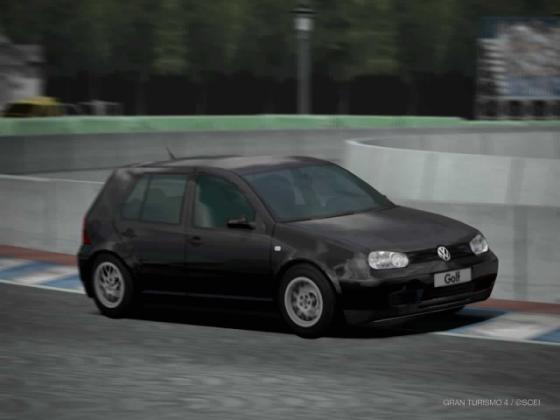
-----------EXTERIOR / HISTORY------------ Fahrfugnügen, or
Fukengrüven?
We've all heard of hot-hatches, right? Well here's a warm-hatch. ;) At
all times, the Mk. IV generation of Golfs can lay down some law, but feel less extreme than some other front-drives while
doing so. These Golfs do their job in a more civil manner at first, and only once great power is added will the heat also
rise.
Like the Honda Civic, the VW Golf has been around for decades, and we all recognize this compact the world over.
Unlike the Civic, the Mk IV Golf didn't get a major facelift when it first appeared in '99, and doesn't look much different
from Mk. III Golfs (which have been around since '93). By the time GT2 was released, Golfs were looking a bit dated.
Mk IV was a brand-new generation, but hasn't had as major of a change as Honda's Civic. But never mind.
The Golf has
won "Car of the Year" many times during its 25+ year lifespan, and often has been the best-selling hatch in Europe
and other parts of the world. Over the years, there have been many Golf and Civic clones produced by other manufacturers--yet
nobody can touch the mundane (yet distinctive) looks of the originals.
The Golf began its life in crisis. Towards the
end of the '70s, Volkswagen's air-cooled, rear-engine Beetles were finally not selling as strongly as they had been, and it
was up to this new car (the Golf) to save the day. Giulia from Ital Design was commisioned to design the new car. He
came up with something that was just as cute as the Beetle, and has proven to be just as commonplace and popular world-wide.
20 years later, we're now up to the Golf's fourth generation of cars (Mk. IV), and here we are with several Golfs
in some of our games. GT2 includes four models, and GT4 has a couple. GT5 includes a Premium model, as well as the all
wheel-drive R32. For this review, I'm looking at one of the 5-cylinder 5-doors from GT2, as well as the used 2001
GTi of GT4 and Premium of 5. The Golf R32 is also from the 4th generation, however it has 4-wheel drive and deserves its own
review.
The cars in our games can be had in 14 colors, and they have typical dimensions for a hatchback. These
are middle-weight cars... about 400 pounds lighter than some other 5-door autos in our games, but heavier than many
Japanese front-drives. Any Golf in GT2 can get a race-kit, and some of them even come with seperate sponsorship schemes. Lightened
all the way, the V5 of this review falls to an acceptable 2,416 pounds. I'm not sure what Golfs in other
games can be stripped to yet.
To look at them, Golfs may not be the most exciting cars in our
garage, but they are welcome faces, nonetheless.
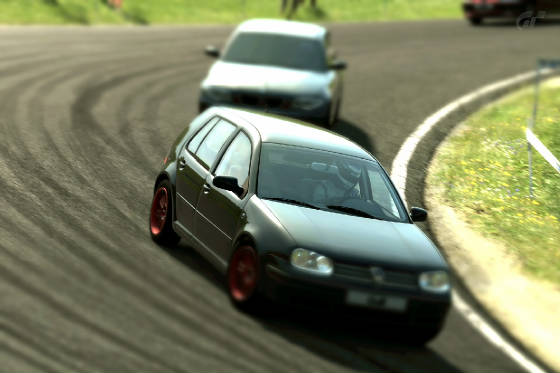
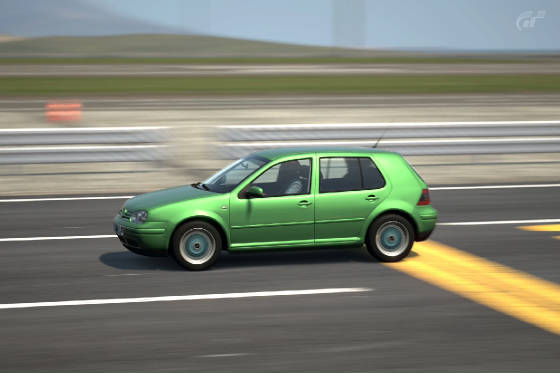
------------ENGINE / DRIVETRAIN----------------
In real-life, the Golf Mk. IV can be had with many different
engines, with different sizes and capability. Depending on the game, we've got inline-4, V5, and V6 configurations; naturally-aspirated
cars and turbos. Since there really is a huge difference between them, it makes sense to discuss a couple cars
from each game that they appear in seperately.
GT2
So far, I've only driven the V5-engine Golf in this game. Performance-wise, the Golf 2.3 V5 can be
modified with three stages of turbos. At best, the V5 can make 350 horses. Only the GTi 1.8T from
this game (which I never drove) gets more (384 hp). Lightly modified (no turbo) a Golf
of any kind winds towards 100 mph with consistentcy, but the party's all over by the time we're in 4th gear...not because
the transmission is too tall, but perhaps it's the forces of airflow kicking in, slowing the car down.
At the
test track, the Golf's top speed will max about 500 rpm below redline. Torque kicks-in early but drops off, so that by the
time we're at the 5,900 rpm peak, less than 200 ft-lbs. are being produced. This is unlike some Japanese engines, in
which torque and power follow a similar path. If a turbo is bought and installed, the torque curve reverses; both horsepower
and torque peak at exactly the same place (6,100 rpms) in a fully-modified car.
For frugal folks, it can be beneficial
to get super-close gearing for a lightly modified car, even for big tracks. This can be changed to stock gearing or close
gearing once the power is raised. We can't diss the Golf 5-door too much, despite its practicality. It is very welcome
in GT2, but were not dealing with the fastest car here! Even amongst other hatches, the Golf just lacks a bit in this
game.
GT4
As noted before, in GT4 the 1.8 liter turbo engine can be found in the used '01 GTi, while a V6 engine
sits in the R32 all-wheel drive car. But I'm not reviewing the R32 now. It's of a much different class.
Intercoolers are available for the 1.8, as well as 3 turbos. Despite all this, it's a
rather slow engine. Unlike the GTis of today, or the front-drive Audi TT 1.8T, the Golf is not gonna win
any awards for speed in GT4. At best, we can only achieve a disappointing 296 horsepower with 265
foot-pounds. It is, however, a very smooth engine, very predictable. Very torquey
too, and since this car's amazingly flat torque band peaks at just 1,750 rpms, the 1.8 generates
lots of torque. There is some 1st-gear wheelspin, but it's easy to avoid. A momentary drop in gas will quickly
tame it back to its cage.
Very predictable. It's a warm-hatch, rather than a hot-hatch...see?
This powerplant becomes a star in some of GT4's lower-powered races for a couple reasons.
[1] Useful torque can be found at about 4,000 rpms in 3rd gear, and 2,000
rpms in 2nd, even from a stock engine. What I mean by "useful" is: does this car gain
speed at such rpms? Even if the front wheels are turned heavily? Yes and yes. Gas must be kept no higher than about halfway
while you're mid-corner, or this swell of torque will ruin everything with understeer, but once you're clear for liftoff,
you can plant the power EARLY in this car. Once you do so, the grip is amazing...even with N3 (road) tires. Now
check this out. Here's the second reason the Golf is a star that plays its part well.
[2] In real-life, I have
read the IV generation GTis have an electronic locking differential. Below is a quote from www.nctd.com for a review of the Golf GTi:
**...GLS and GTI models come with Volkswagen's
Anti-Slip Regulation system (ASR), which detects wheel slippage and applies braking force to that particular wheel. Working
with an Electronic Differential Lock at speeds below 25 mph, ASR controls throttle response to maximize traction
and minimize slipping for enhanced driver control in tight cornering situations. Pressing a button in the center of the dash
turns ASR off.**
In GT4, we don't have ASR, but it definately seems PD has taken the "electronic lock differential"
into consideration because this car NEVER gets flustered out of any corners of any kind while power is near-stock. Even
when powered heavily, the front wheels are easy to control under power...only with a Stage 2 turbo (about 250 horsepower)
did I finally need to install a 1-way differential. This "locking-differential" effect (assuming PD actually
did model it) lasts well beyond 25 mph, too. Even first gear is useful, tho some taming is required when using 1st.
Notice
also the turbo boost gauge, which doesn't get much higher than 1/2 way. Rather than packing all the boost available
into a small 1,000 rpm compartment as a Civic does, Volkswagen has managed to spread its boost delivery over
many revs. Front-end power delivery is so solid, so predictable!
What's not so great is the transmission.
In real-life, this car delivers great mileage for a turbocharged car (24 mpg city/31 mpg highway). Part of the reason is because
the transmission is geared tall. This is great for gas-mileage, since a real-life driver can spend most of his or her time
at low rpms without activating heavy turbo boost as they drive around town. But it's not so great for racing. 2nd and 3rd
gear in particular are to blame. This car has such great delivery out of turns, it's a shame that within a few seconds, gearing
turns all this to mush. Tho it is possible to use a stock transmission in the GTi Cup, Euro Hot Hatch, and Swarzwald
Liga A, the close gearbox makes a huge difference, making sure you get ALL the horsepower you can
get when the car needs it. Unfortunately, close gears aren't tall enough to get this car safely down long straights. So either the
stock gearbox gets pulled off the truck, or some drivers will opt for full-custom gears.
Peak power is at 5,700,
redline at 6,000, and the RPM limit at 6,500, so manual transmission drivers will rarely
miss an opportunity unless they screw up their shifting. Automatic drivers should be okay too, unless they're driving a car
with a stock transmission, and don't know they can leave their car in gear by holding R2 (or whatever button is hotkeyed)
to garner a few extra revs.
GT5
Power
has never been this car's stronger point in earlier games, and in GT5 the tradition rolls on. The same 1.8 liter turbo engine
is used in either front-drive Golf we can purchase. We can still rely on this car's rather wide torque delivery (especially
out of slower areas) and the Golf still makes a great car to do some beginner or amateur races early on. Problem is in GT5,
some of the races are so damn easy, this car's 147 stock power is often way too much up against the opposition. For now, this portion of the review is going to be on hold. Perhaps this is
some racing in 5 which will warrant looking into stacking up some power, but so far, it's (sadly) the B-spec drivers who will
be using such power, more than likely.
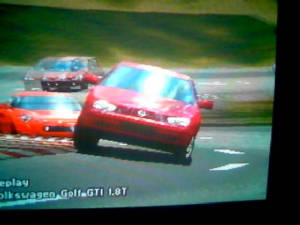
-----------CHASSIS / HANDLING-------------
GT2
Sorry, I know this review is lacking inspiration. I'll be quick
here.
The Golf is a front-drive car and a typical one at that. With stock tires, understeer can be expected above 60
mph, so get sports unless you're up for a challenge. Once the power is above Stage 2 it's a good idea to get racing slicks
bla bla bla.
The main thing to watch for under power is the back end of this grocery-hauler, which tends to lean alot
in turns. Generally, the Golf handles pretty well, though. Exotic parts like the LSD unit, full-racing suspension, and super-soft
tires never really become necessary items till you're tackling stupid-fast races like the GT300.
Make sure you don't
forget to pick up the kids after done racing.
GT4
Not sure why the GT2 part of this review (which I wrote in 2004) was so short and so weak. Maybe I was
having a bad day or something. Or maybe it really IS the Golf as portrayed in GT2...perhaps it wasn't very exciting to drive.
Well that certainly has changed. The Golf IV in GT4 feels lots more inspiring to drive, despite its lack of
available power. As mentioned before, we have a very grippy front-end matched with a smooth, torquey motor. So, lots of traction
is here, and we can use it safely. Rarely will the Golf feel like it's driving on firecrackers, like we'd find in
some Civics or Neons. At times, this car can be hefted out of corners so smoothly, it feels almost like
it's got 4-wheel drive! Occasional chirping from those front wheels is what destroys this illusion.
We
also have some fantastic brakes, and steering that reliably noses the car into turns. You may get into the habit
(as I did) of braking late, and then braking too late. Entry-corner understeer eventually ruins, but
the Golf otherwise gives us lots to work with when trying to out-brake the competition. As in real-life, the Mk. IV Golf of GT4 is
also not prone to leaning too much, and feels solid and planted most of the time.
But once you get to really know this
car is when things start to really heat up. After awhile, you may even start to like understeer!
The Golf can be driven right to its limits...tires screaming, understeer just a tap of gas away!! At this
point, you have the choice to HAMMER IT (make sure the turn you're in is a wide one first), causing some extreme, controllable under-drift!
Notice the lack of inner-tire wheelspin, too. I really do believe PD modeled that electronic differential at times like these.
...Of
course, if you choose not to hammer it, the Golf will ride its limit safely; unwanted surprises a rarity.
And
that's not all. There are all those moments when you're neck-and-neck with some loser in some corner, and you STOMP the gas
in 2nd gear, knowing the car will reliably weave its way out onto the straight, and grip will dominate over understeer
so long as the gas is kept reigned back where it should be. But it won't require too much reigning back. There is some
leeway here.
Abrupt brake-&-turns from high speeds can also induce some very tasty trail-braking snap-maneuvers,
especially during Lap 2 at some tracks, since the front tires will be warmed, but the rear ones still cold. At such times, I
was able to JUMP on the gas early while the Golf was in a full slide, understeering back to safety!
GT5
The real-life car comes equipped with ABS, EBD (Electronic Brake Distribution), and TCS.
To simulate, this I initially drove my green-colored Golf with ABS, Active Steering (mild), and TCS on. Drove multiple laps
around Grand Valley, since I'm trying to re-learn this track in this game for the Gran Turismo World Championship.
With
all the aids on, the Golf feels incredibly sterile, more like a cold hatch than a warm one. Understeer is always taken care
of (even with the mild active steering setting, as opposed to "strong"), and TCS takes care of any wheelspin that could possibly
show up, even as I'm driving around with soft radials on. So let's turn everything off except ABS.
And the thing
is, this one is really not much different now, at least not at first. Not during the Sunday Cup or Clubman, anyways. There's
a smidge more understeer when really forcing the issue, but this is easily taken-care of by simply backing away from
that throttle. Doesn't take much backing away, though, before we know it, the Golf grips its way in, and we're using as much
throttle as we can.
Just as described in GT4, the Golf still feels kinda like an all-wheel drive, even on cheap tires.
There simply is no wheelspin or front-end chirping, not while power is stock. But then, you start to race this car.
Not in the Beginner Series, and not in the Amateurs. The first time I really drove my Golf hard in this game happened during
the Expert Series during Schwarzwald League A. At both tracks (Nürburgring GP/F and Tokyo Route
246) there isn't a lot of power involved, yet one must drive to this car's very limits to survive. "Ahh, there you are", says Mister Understeer, giving us his usual
wicked grin. "Welcome back! Did you miss me?" It honestly seems
worse now than it does in GT4. Somehow, the amount of pushing this car now displays can be painstakingly dreadful at
times. Perhaps it's because the majority of racing in 4 is done on medium sport tires, but in GT5 I was using hard sports
so I could match what the AI has. Whatever the case, late-braking is not quite as much of an option as it was during some
easier races, and trail-braking seems absolutely absent most of the time. That's something I definitely was
not expecting. Everything else is similar to the way it was, though.
Lots of traction out of slower-speed turns. Wheelspin? It's as rare as a 3-dollar bill. The engine's mighty-low torque
can still move the car from lower revs, although this is more evident during some easier races, where the majority of
AI tends to get a bit timid as they re-introduce some throttle. Unfortunately,
the really fun behavior described during GT4 (where I could jack-knife my Golfs into high-speed turns) is no longer an option.
Tires don't warm as ridiculously quickly as they did in the fourth game, and front-end grip tends to be kept more consistent,
not flaring or spiking the way it did during GT4's Lap Twos. On the other hand, bringing power up past 250 is where we'll
start to see MK IV Golfs start to go from lukewarm to mildly hot, but it's uncommon to see one of these hatches completely
losing composure out-of-of turns.
Summary
I'm not sure why this car is named "Golf". The
word "golf" has two meanings in German. One meaning is the same as "gulf" in English (in other words, Gulf of Mexico),
and the other meaning is the actual sport of golf. Apparently we have a third meaning with this car, which appears
mundane, but can be an amazing machine at times.
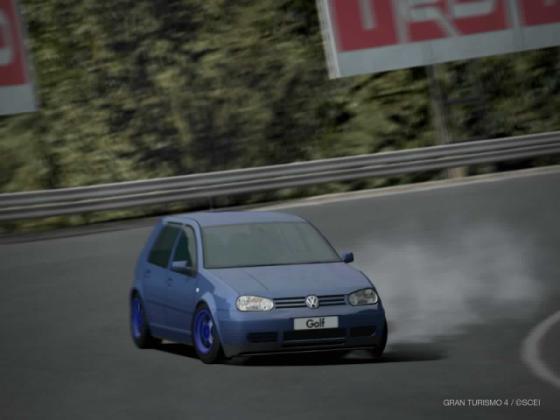
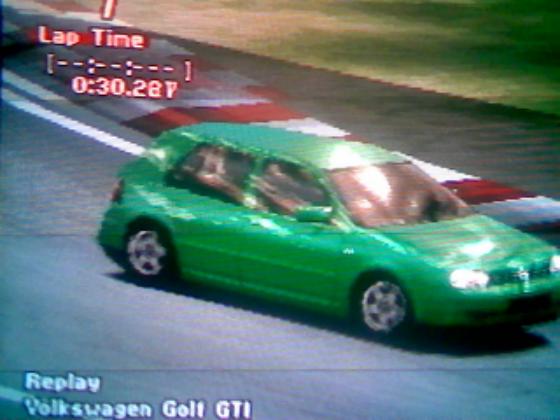
PROS
1). Acceptable front-drive
acceleration in lower gears. The Mk. IV Golf is comparable to other vehicles of its class.
2). Three
Stages of turbo available in all games. GT4 has intercoolers, as well.
3). High tossability factor! Not too much rear
overhang, but just enough to induce oversteer (GT2). In GT4, wicked trail-brakes and controllable slides are more likely,
and should convince even the staunchest anti-FWD drivers out there to take notice. GT5 (oddly) is the weakest game here.
Golfs in this game always remain rather mild-mannered, so far as cornering goes.
4). Lots of colors to
choose from.
5). GT2: Any transmission can be used in a lightly modified Golf. With the power up, only the super-close
becomes obsolete on longer tracks.
6). Easy on that gas. I raced this car in GT4, doing the GT Cup, Euro
Hot Hatch, and Schwarzwald Liga A. Only once did I see a bar of fuel vanish.
7). An extremely grippy front-end
that can be bent and twisted under power.
8). Excellent brakes & braking abilities.
9). Reliable, smooth torque
too. This is more evident in GT4 and 5 than it is in the second game.
10). Any Golf in GT2 can accept racing bodywork. The Premium model in GT5
can also be crafted up this way.
11). In GT4, Golfs can be tuned at HPA Motorsports in the Tuner hall, saving
time since you won't have to go all the way back to the dealer to get parts & services.
12). GT5: The Golf has
become a Premium model. Matter of fact, PD has included two of these vehicles ('01 and '05 model years) for whatever reason.
CONS
1). Price seems a bit high in GT2.
2).
In GT4, used GTis can take weeks to show up.
3). Not the speediest of hot-hatches. Some Mk. IV Golfs in GT2
can take on more power than they can in do in GT4/5.
4). GT2: Major understeer kicks in anywhere from 60 to 90 mph,
depending on which tires and suspension you're using. Oddly, this isn't as much of a prob in GT4 or 5, though understeer is
still this car's biggest fault.
5). A rather dopey car to race, despite all its good points. The bulky back-end
either kills some of the Golf's maneuverability, or can cause major jack-knifes under hard braking from high speeds (not true
in GT5). Pros will delight here, but some novices might find themselves in a spinning Golf ball. ha ha.
6). Nothing
flashy about this one. Generation IV Golfs aren't as eye-catching as Mk Vs or VIs.
7). GT2: Though it is
possible to win some serious bucks in enduros when racing a Golf, eventually its usefullness ends. In GT4, we can't put
a front-drive Golf in any high-paying events at all, with one exception (the two Special Event Costa di Amalfi races on the
Beginner level).
8). Tall stock gears make this car feel not so raceworthy at first (not like a Civic, anyways).
Close gears can be used for some situations, but a full-custom tranny might be needed eventually.
9). Some of those exhaust
sounds (particularly the sports exhaust) are familiar, eh? That's because their soundbyte is shared with several
other cars which aren't Volkswagens. This seems truest in earlier games.
10). The "Premium" dashboard in GT5 shows
only a third of the tach (the steering wheel blocks the rest). Speedometer is also somewhat useless, even for those using perepheral
vision.
Published: August 31st, 2004
ReEdited: January
1st, 2009
GT5 Info: January 8th, 2013, and again on November 19, 2013
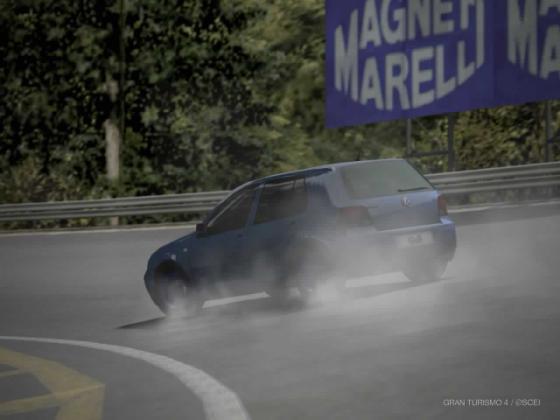
|



